brake MITSUBISHI OUTLANDER 2018 Owner's Manual (in English)
[x] Cancel search | Manufacturer: MITSUBISHI, Model Year: 2018, Model line: OUTLANDER, Model: MITSUBISHI OUTLANDER 2018Pages: 441, PDF Size: 13.71 MB
Page 5 of 441

Instruments and controls1-3 Overview
1
Supplemental restraint system (SRS) - airbag (for front passenger’s seat) P. 4-35, 4-42
Glove compartment P.5-239Card holder P.5-239
Selector lever P.5-68, 5-75Drive mode-selector (if so equipped) P.5-83S-AWC drive mode-selector (if so equipped) P.5-86
Parking brake lever P.5-53
Heated seat switch (if so equipped) P. 4 - 8
Selector lever P.5-68, 5-75
Electric parking brake switch P.5-54
Brake auto hold switch P.5-93
Drive mode-selector (if so equipped) P.5-83
Electric parking brake type
Parking brake lever type
Heated seat switch (if so equipped) P. 4 - 8
BK0249100US.book 3 ページ 2017年5月10日 水曜日 午前8時49分
Page 12 of 441
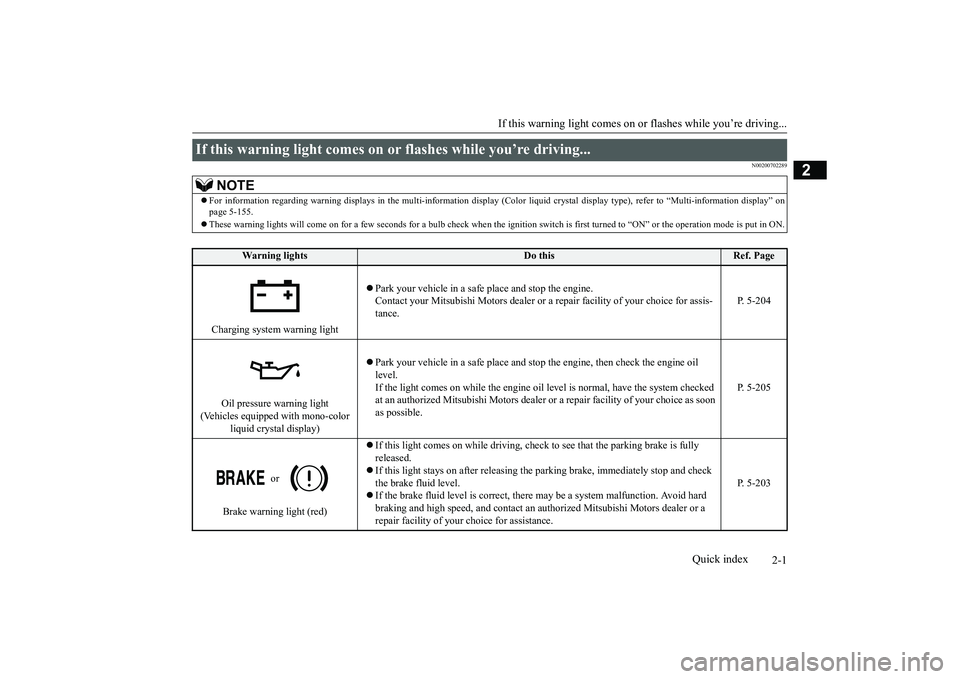
2-1
2
If this warning light comes on or
flashes while you’re driving...
Quick index
N00200702289
If this warning light comes on
or flashes while you’re driving...
NOTE
For information regarding warning
displays in the multi-information display (Color
liquid crystal display
type), refer to “Mult
i-information display” on
page 5-155.These warning lights will co
me on for a few seconds for a bulb check when the i
gnition switch is
first turned to “ON” or the op
eration mode is put in ON.
Wa rn in g l ig h t s
Do this
Ref. Page
Charging system warning light
Park your vehicle in a safe
place and stop the engine.
Contact your Mitsubishi Motors dealer or a re
pair facility of your choice for assis-
tance.
P. 5-204
Oil pressure warning light
(Vehicles equipped with mono-color
liquid crystal display)
Park your vehicle in a safe
place and stop the engine, then check the engine oil
level.If the light comes on while the engine oil le
vel is normal, have the system checked
at an authorized Mitsubishi
Motors dealer or a repair fa
cility of your choice as soon
as possible.
P. 5-205
or
Brake warning light (red)
released.If this light stays on after
releasing the parking brake,
immediately stop and check
the brake fluid level.If the brake fluid level is correct, there
may be a system malfunction. Avoid hard
braking and high speed, and contact an au
thorized Mitsubishi Mo
tors dealer or a
repair facility of your
choice for assistance.
P. 5-203
BK0249100US.book 1 ページ 2017年5月10日 水曜日 午前8時49分
Page 13 of 441
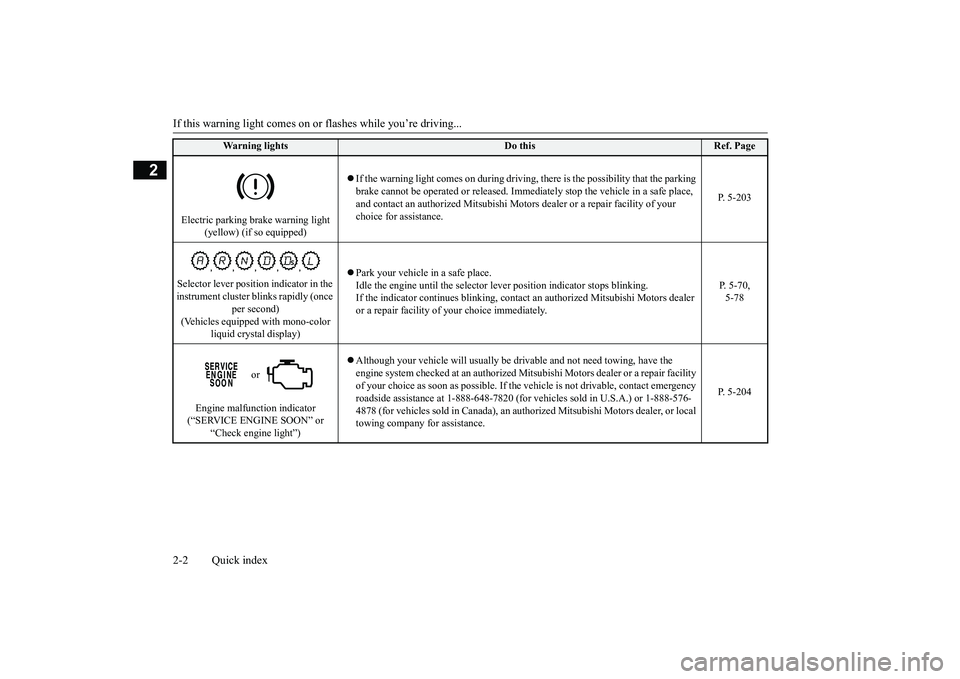
If this warning light comes on or flashes while you’re driving...2-2 Quick index
2
Electric parking brake warning light
(yellow) (if so equipped)
If the warning light comes on during driving,
there is the possibility that the parking
brake cannot be operated or released. Immedi
ately stop the vehicle
in a safe place,
and contact an authorized Mi
tsubishi Motors dealer or a repair facility of your
choice for assistance.
P. 5-203
Selector lever position indicator in the instrument cluster bl
inks rapidly (once
per second)
(Vehicles equipped with mono-color
liquid crystal display)
Park your vehicle in a safe place.Idle the engine until the selector
lever position indica
tor stops blinking.
If the indicator continues bl
inking, contact an authorized
Mitsubishi Motors dealer
or a repair facility of
your choice immediately.
P. 5-70,5-78
or
Engine malfunction indicator (“SERVICE ENGINE SOON” or
“Check engine light”)
Although your vehicle will usually be dr
ivable and not need towing, have the
engine system checked at an authorized Mi
tsubishi Motors dealer
or a repair facility
of your choice as soon as possible. If the
vehicle is not drivab
le, contact emergency
roadside assistance at 1-888-648-7820 (for
vehicles sold in U.S.A.) or 1-888-576-
4878 (for vehicles sold in Canada), an aut
horized Mitsubishi Moto
rs dealer, or local
towing company for assistance.
P. 5-204
Warning lights
Do this
Ref. Page
BK0249100US.book 2 ページ 2017年5月10日 水曜日 午前8時49分
Page 16 of 441

If this problem occurs...
Quick index 2-5
2
N00200901936
If this problem occurs...
Problem
Do this
Ref. Page
Unable to turn the key.(except for vehicles equipped with the F.A.S.T.-key)
Will not turn from “LOCK” to “ACC”.
(Vehicles with steering lock system)
Turn the key while turning the steering wheel in either direction.
P. 5-65
Will not turn from “ACC” to “OFF” or “LOCK”.Check the position of the selector lever.The key cannot be removed unless the selector
lever is set to the “P” (PARK) position.
On vehicles with stee
ring lock system, push the key in
at the “ACC” posi
tion and keep it
depressed until it is turned to the “LOCK” position.
P. 5-64
The engine does not start when the engine switch is pressed.(for vehicles equipped with the F. A . S . T. - k e y )
Make sure the selector lever is in the “P” (P
ARK) position, and then press the engine switch
while depressing the brake pedal.
P. 5-25
The F.A.S.T.-key does not oper-ate.(for vehicles equipped with the F. A . S . T. - k e y )
change the operation mode. Use the emergency
key to lock and unlock the driver’s door.
P. 5-27,5-28
BK0249100US.book 5 ページ 2017年5月10日 水曜日 午前8時49分
Page 17 of 441

If this problem occurs...2-6 Quick index
2
Cannot shift the selector lever from the “P” (PARK) position.
Shift the selector lever while pressing the brake pedal.Check that the ignition switch
or the operation mode is in ON.
P. 5-68
The windows are fogged up.
Push the defogger switch to
change to the “ ” position.
P. 7-8
The engine does not start.The lights do not come on.The lights are dim.The horn does not honk.The horn sound is weak.
Have the battery checked. Rech
arge or replace as needed.
P. 8-2,9-13
Problem
Do this
Ref. Page
BK0249100US.book 6 ページ 2017年5月10日 水曜日 午前8時49分
Page 19 of 441
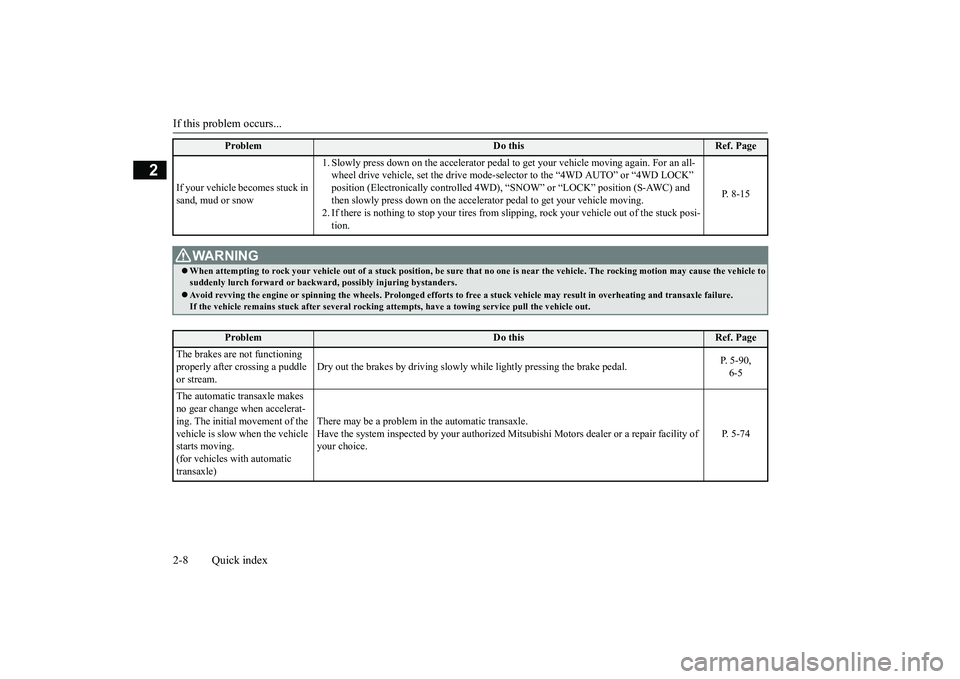
If this problem occurs...2-8 Quick index
2
If your vehicle becomes stuck in sand, mud or snow
1. Slowly press down on the accelerator pedal to
get your vehicle moving again. For an all-
wheel drive vehicle, set the drive mode-sel
ector to the “4WD AUTO” or “4WD LOCK”
position (Electronically cont
rolled 4WD), “SNOW” or “L
then slowly press down on the accelera
tor pedal to get your vehicle moving.
2. If there is nothing to stop your tires from sli
pping, rock your vehicle out of the stuck posi-
tion.
P. 8-15
WA R N I N GWhen attempting to rock your vehi
cle out of a stuck position, be su
re that no one is near the ve
hicle. The rocking motion may c
ause the vehicle to
suddenly lurch forward or backward, possibly injuring bystanders.Avoid revving the engine or spinning the wh
eels. Prolonged efforts to free a stuck ve
hicle may result in
overheating and transa
xle failure.
If the vehicle remains stuck after
several rocking attempts
, have a towing service pull the vehicle out.
Problem
Do this
Ref. Page
The brakes are not functioning properly after crossing a puddle or stream.
Dry out the brakes by driving slowly
while lightly pressing the brake pedal.
P. 5-90,6-5
The automatic transaxle makes no gear change when accelerat-ing. The initial movement of the vehicle is slow when the vehicle starts moving.(for vehicles with automatic transaxle)
There may be a problem in the automatic transaxle.Have the system inspected by your
authorized Mitsubishi Motors de
aler or a repair facility of
your choice.
P. 5-74
Problem
Do this
Ref. Page
BK0249100US.book 8 ページ 2017年5月10日 水曜日 午前8時49分
Page 65 of 441
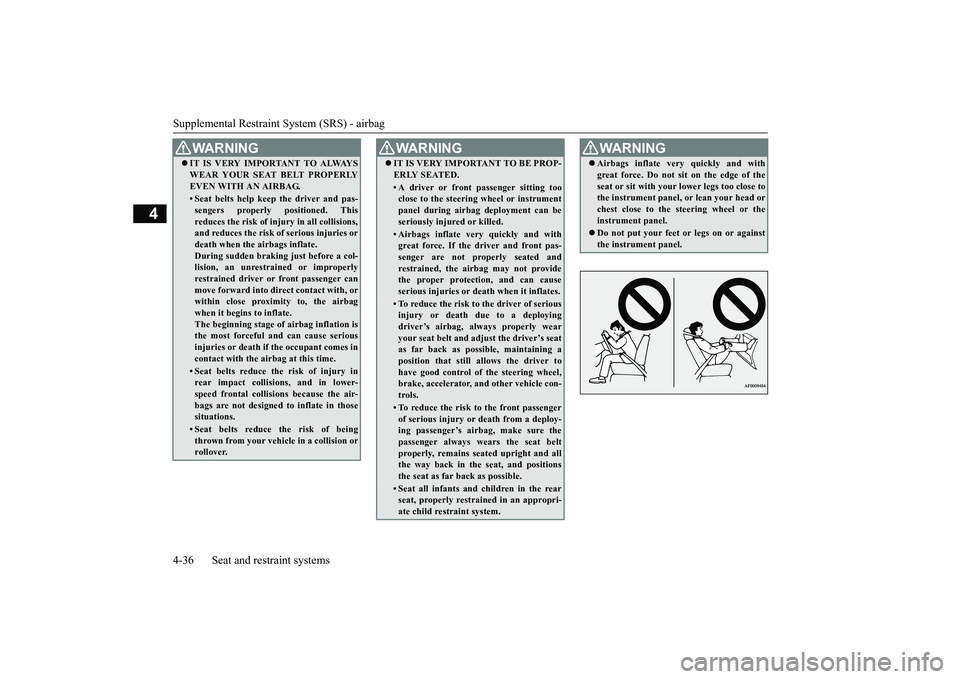
Supplemental Restraint System (SRS) - airbag4-36 Seat and restraint systems
4
WA R N I N GIT IS VERY IMPORTANT TO ALWAYSWEAR YOUR SEAT BELT PROPERLYEVEN WITH AN AIRBAG.• Seat belts help keep the driver and pas-sengers properly positioned. Thisreduces the risk of injury in all collisions,and reduces the risk of serious injuries ordeath when the airbags inflate.During sudden brakin
g just before a col-
lision, an unrestra
ined or improperly
restrained driver or front passenger canmove forward into di
rect contact with, or
within close proximity to, the airbagwhen it begins to inflate.The beginning stage of
airbag inflation is
the most forceful and can cause seriousinjuries or death if the occupant comes incontact with the ai
rbag at this time.
• Seat belts reduce the risk of injury inrear impact collisions, and in lower-speed frontal collisions because the air-bags are not designed
to inflate in those
situations.• Seat belts reduce the risk of beingthrown from your vehi
cle in a collision or
rollover.
WA R N I N GIT IS VERY IMPORTANT TO BE PROP-ERLY SEATED.• A driver or front passenger sitting tooclose to the steering wheel or instrumentpanel during airbag deployment can beseriously injure
d or killed.
• Airbags inflate ve
ry quickly and with
great force. If the driver and front pas-senger are not properly seated andrestrained, the airbag may not providethe proper protection, and can causeserious injuries or death when it inflates.• To reduce the risk to the driver of seriousinjury or death due to a deployingdriver’s airbag, al
ways properly wear
your seat belt and ad
just the driver’s seat
as far back as possible, maintaining aposition that still
allows the driver to
have good control of the steering wheel,brake, accelerator,
and other vehicle con-
trols.• To reduce the risk to the front passengerof serious injury or death from a deploy-ing passenger’s airbag, make sure thepassenger always we
ars the seat belt
properly, remains seat
ed upright and all
the way back in the seat, and positionsthe seat as far back as possible.• Seat all infants and children in the rearseat, properly restrain
ed in an appropri-
ate child restraint system.
WA R N I N GAirbags inflate very
quickly and with
great force. Do not sit on the edge of theseat or sit with your
lower legs too close to
the instrument panel,
or lean your head or
chest close to the steering wheel or theinstrument panel.Do not put your feet or
legs on or against
the instrument panel.
BK0249100US.book 36 ページ 2017年5月10日 水曜日 午前8時49分
Page 68 of 441
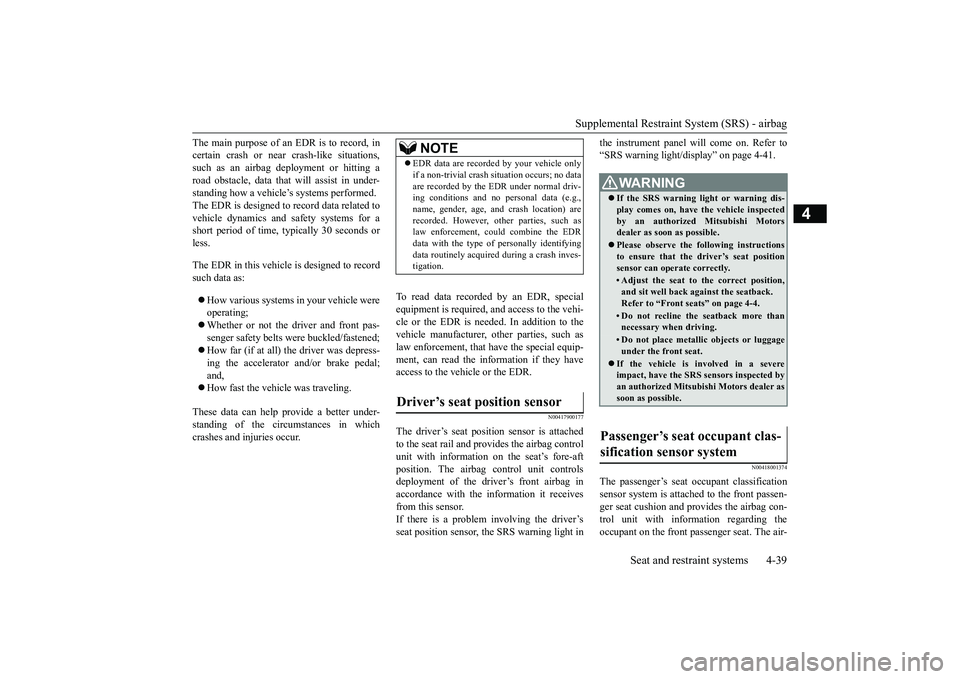
Supplemental Restraint System (SRS) - airbag
Seat and restraint systems 4-39
4
The main purpose of an EDR is to record, incertain crash or near
crash-like situations,
such as an airbag deployment or hitting aroad obstacle, data that
will assist in under-
standing how a vehicl
e’s systems performed.
The EDR is designed to record data related tovehicle dynamics and safety systems for ashort period of time,
typically 30 seconds or
less.The EDR in this vehicle is designed to recordsuch data as:How various systems
in your vehicle were
operating;Whether or not the driver and front pas-senger safety belts we
re buckled/fastened;
How far (if at all) the driver was depress-ing the accelerator and/or brake pedal;and,How fast the vehicle was traveling.
These data can help provide a better under-standing of the circumstances in whichcrashes and injuries occur.
To read data recorded by an EDR, specialequipment is required, and access to the vehi-cle or the EDR is needed. In addition to thevehicle manufacturer, ot
her parties, such as
law enforcement, that have the special equip-ment, can read the information if they haveaccess to the vehicle or the EDR.
N00417900177
The driver’s seat position sensor is attachedto the seat rail and provides the airbag controlunit with information on the seat’s fore-aftposition. The airbag control unit controlsdeployment of the driver’s front airbag inaccordance with the information it receivesfrom this sensor.If there is a problem involving the driver’sseat position sensor, the SRS warning light in
the instrument panel will come on. Refer to“SRS warning light/dis
play” on page 4-41.
N00418001374
The passenger’s seat oc
cupant classification
sensor system is attach
ed to the front passen-
ger seat cushion and provides the airbag con-trol unit with information regarding theoccupant on the front passenger seat. The air-
NOTE
EDR data are recorded by your vehicle onlyif a non-trivial crash si
tuation occurs; no data
are recorded by the EDR under normal driv-ing conditions and no personal data (e.g.,name, gender, age, a
nd crash location) are
recorded. However, ot
her parties, such as
law enforcement, could combine the EDRdata with the type of
personally identifying
data routinely acquire
d during a crash inves-
tigation.
Driver’s seat position sensor
WA R N I N GIf the SRS warning light or warning dis-play comes on, have the vehicle inspectedby an authorized Mitsubishi Motorsdealer as soon as possible.Please observe the following instructionsto ensure that the driver’s seat positionsensor can operate correctly.• Adjust the seat to the correct position,and sit well back
against the seatback.
Refer to “Front seats” on page 4-4.• Do not recline the seatback more thannecessary when driving.• Do not place metallic objects or luggageunder the front seat.
If the vehicle is involved in a severeimpact, have the SRS sensors inspected byan authorized
Mitsubishi Motors dealer as
soon as possible.
Passenger’s seat occupant clas-sification sensor system
BK0249100US.book 39 ページ 2017年5月10日 水曜日 午前8時49分
Page 82 of 441
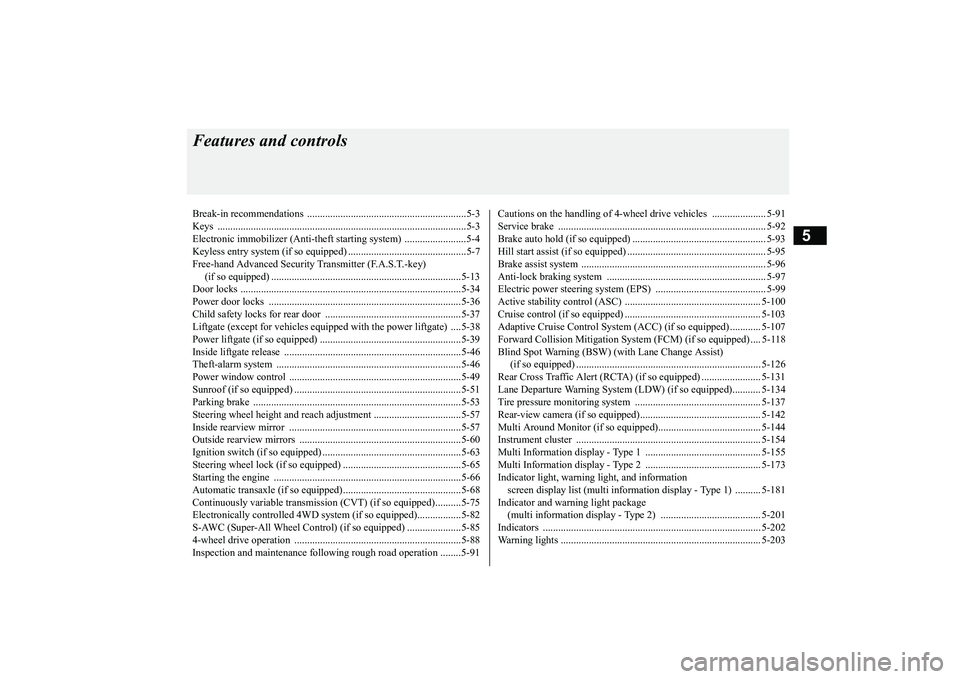
5
Features and controlsBreak-in recommendations ..............................................................5-3Keys .................................................................................................5-3Electronic immobilizer (Anti-theft starting system) ........................5-4Keyless entry system (if so equipped) ..............................................5-7Free-hand Advanced Security
Transmitter (F.A.S.T.-key)
(if so equipped) ..........................................................................5-13Door locks ......................................................................................5-34Power door locks ......
...........
...........
...........
...........
...........
.........
.....5-36
Child safety locks for rear door ..........
...........
.........
.........
.........
.....5-37
Liftgate (except for vehi
cles equipped with the
power liftgate) ....5-38
Power liftgate (if so equipped) .......................................................5-39Inside liftgate release .....................................................................5-46Theft-alarm system ........................................................................5-46Power window control ...................................................................5-49Sunroof (if so equipped) .................................................................5-51Parking brake .................................................................................5-53Steering wheel height and reach adjustment ..................................5-57Inside rearview mirror ...................................................................5-57Outside rearview mirrors ...............................................................5-60Ignition switch (if so equipped) ......................................................5-63Steering wheel lock (if so equipped) ..............................................5-65Starting the engine .........................................................................5-66Automatic transaxle (if so equipped)..............................................5-68Continuously variable transmission
(CVT) (if so equipped)..........5-75
Electronically controlled
4WD system (if so equipped).................5-82
S-AWC (Super-All Wheel Control) (if
so equipped) .....................5-85
4-wheel drive operation .................................................................5-88Inspection and maintenance followi
ng rough road operation ........5-91
Cautions on the handling of 4-wheel dr
ive vehicles ..................... 5-91
Service brake ................................................................................. 5-92Brake auto hold (if so equipped) .................................................... 5-93Hill start assist (if so equipped) ...................................................... 5-95Brake assist system ........................................................................ 5-96Anti-lock braking system .............................................................. 5-97Electric power steering system (EPS) ........................................... 5-99Active stability control (ASC) ..................................................... 5-100Cruise control (if so equipped) ..................................................... 5-103Adaptive Cruise Control System (ACC)
(if so equipped) ............ 5-107
Forward Collision Mitigation System
(FCM) (if so equipped) .... 5-118
Blind Spot Warning (BSW) (w
ith Lane Change Assist)
(if so equipped) ........................................................................ 5-126Rear Cross Traffic Alert (RCTA) (if so equipped) ....................... 5-131Lane Departure Warning System (LDW
) (if so equipped)........... 5-134
Tire pressure monitoring system ................................................. 5-137Rear-view camera (if so equipped)............................................... 5-142Multi Around Monitor (if so
equipped)..................
...........
........... 5-144
Instrument cluster ........................................................................ 5-154Multi Information display - Type 1 ............................................. 5-155Multi Information display - Type 2 ............................................. 5-173Indicator light, warning light, and information screen display list (multi informati
on display - Type 1) .......... 5-181
Indicator and warning light package (multi information display - Type 2) ....................................... 5-201Indicators ..................................................................................... 5-202Warning lights .............................................................................. 5-203
BK0249100US.book 1 ページ 2017年5月10日 水曜日 午前8時49分
Page 100 of 441
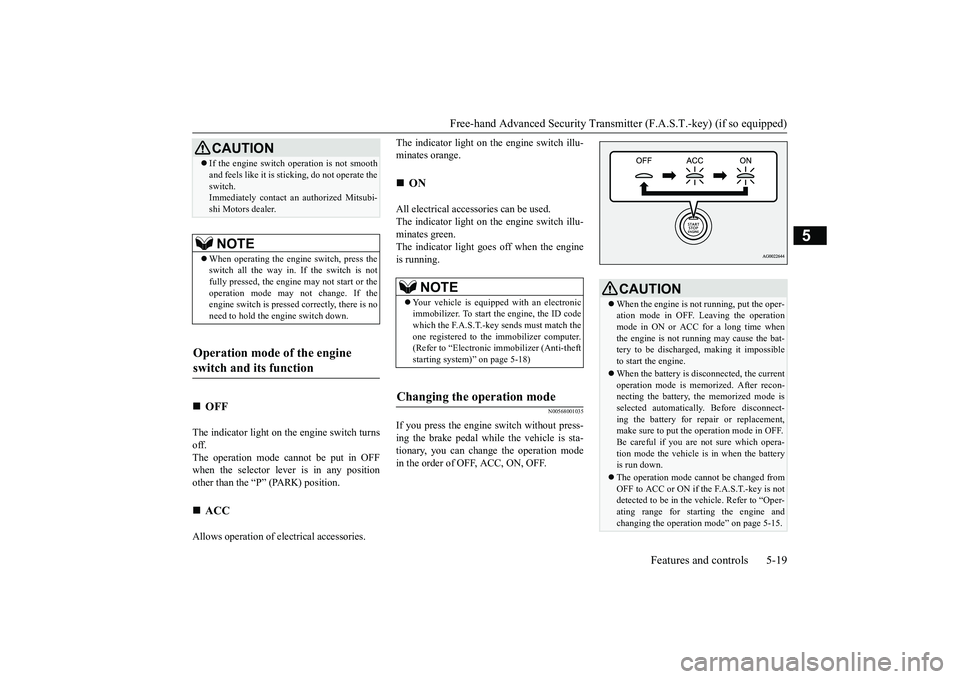
Free-hand Advanced Securi
ty Transmitter (F.A.S.T.-key) (if so equipped)
Features and controls 5-19
5
The indicator light on the engine switch turnsoff.The operation mode cannot be put in OFFwhen the selector lever is in any positionother than the “P” (PARK) position.Allows operation of el
ectrical accessories.
The indicator light on
the engine switch illu-
minates orange.All electrical accessories can be used.The indicator light on
the engine switch illu-
minates green.The indicator light goes off when the engineis running.
N00568001035
If you press the engine
switch without press-
ing the brake pedal whil
e the vehicle is sta-
tionary, you can change the operation modein the order of OFF, ACC, ON, OFF.
If the engine switch
operation is not smooth
and feels like it is st
icking, do not operate the
switch.Immediately contact an authorized Mitsubi-shi Motors dealer.NOTE
When operating the engi
ne switch, press the
switch all the way in. If the switch is notfully pressed, the engine may not start or theoperation mode may
not change. If the
engine switch is presse
d correctly, there is no
need to hold the e
ngine switch down.
Operation mode of the engine switch and its function
OFF
ACC CAUTION
ON NOTE
Your vehicle is equippe
d with an electronic
immobilizer. To start
the engine, the ID code
which the F.A.S.T.-key sends must match theone registered to the immobilizer computer.(Refer to “Electronic immobilizer (Anti-theftstarting system)” on page 5-18)
Changing the operation mode
CAUTIONWhen the engine is not running, put the oper-ation mode in OFF. Leaving the operationmode in ON or ACC for a long time whenthe engine is not running may cause the bat-tery to be discharged
, making it impossible
to start the engine.When the battery is disconnected, the currentoperation mode is memo
rized. After recon-
necting the battery, the memorized mode isselected automaticall
y. Before disconnect-
ing the battery for re
pair or replacement,
make sure to put the operation mode in OFF.Be careful if you are not sure which opera-tion mode the vehicle is in when the batteryis run down.The operation mode cannot be changed fromOFF to ACC or ON if the F.A.S.T.-key is notdetected to be in the
vehicle. Refer to “Oper-
ating range for star
ting the engine and
changing the operation mode” on page 5-15.
BK0249100US.book 19 ページ 2017年5月10日 水曜日 午前8時49分